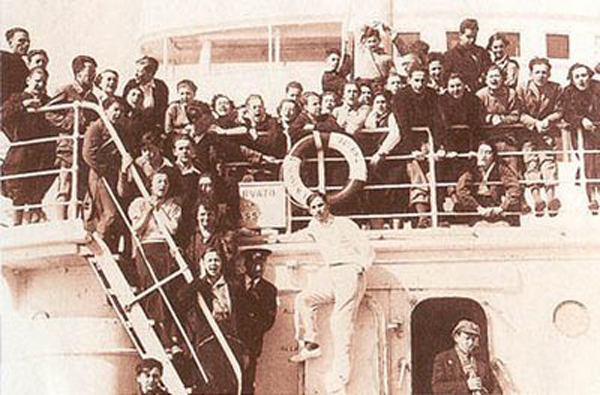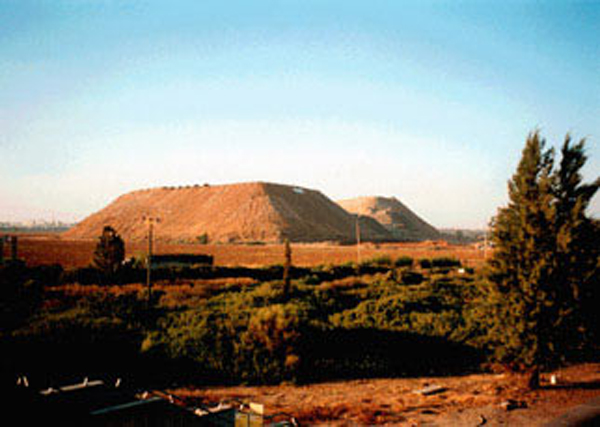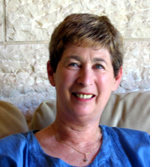


Hadassah celebrates Israel’s 60th birthday with new stem cell research and therapy
By J. Zel Lurie
 DELRAY BEACH, Florida—As Israel approaches its 60th birthday we find that, as unusual, we Jews have contradictory opinions about its successes and failures. DELRAY BEACH, Florida—As Israel approaches its 60th birthday we find that, as unusual, we Jews have contradictory opinions about its successes and failures.
Daniel Gavron, a Jerusalem writer, asks bluntly on a recent op-ed page of the New York Times: “We have won the battle for survival. Why aren’t we celebrating?”
Gabriele Schoenfeld, also of Jerusalem, answers Gavron on the Letters page: “We will win when we no longer have to attend a funeral of young Israelis murdered by terrorists while hiking,“ she writes.
And from a suburb of Jerusalem Stuart Pilchowski writes: “ I don’t know where Daniel Gavron lives but the Israel I live is being rocketed daily by Qassams and targeted regularly by suicide bombers.”
In his op-ed piece Gavron balances the threats from Iran, Hezbollah and Hamas with the agreement by the Palestine Authority to negotiate peace with Israel. He writes:
“Far more significantly, Fatah, the official Palestinian leadership, is negotiating peace with Israel. The member states of the Arab League, headed by Saudi Arabia" have recognized Israel within its pre-1967 borders. And the world’s only superpower, the United States, supports Israel in every way.
I like Gavron because he has published a book in England called Holy Land Mosaic. Stories of Cooperation and Coexistence Between Israelis and Palestinians. It contains three chapters on three organizations that I support: the original bilingual school for Jews and Arabs at Neve Shalom/Wahat al Salam, the Oasis of Peace, which I built many years ago; the four Hand-in-Hand Jewish-Arab schools in Jerusalem, Galilee, Beersheba and Wadi Ara; and the original Hadassah Hospital on Mt. Scopus which serves the Arabs in East Jerusalem.
I will mark Israel’s 6oth birthday by concentrating on Israel’s magnificent achievements in medical science and, in particular, on a new and revolutionary branch called “regenerative medicine.”
I was introduced to regenerative medicine by Professor Dan Gazit of the Hebrew University only a few weeks ago at a meeting in Palm Beach of the American Friends of Hebrew University. I had never heard of the term before.
So on my computer I googled “regenerative medicine” and I learned that more than a dozen universities have founded institutes to investigate possible therapies by embryonic stem cells, that is lines of stem cells taken from human embryos that otherwise would have been destroyed.
Prof. Gazit avoids all controversy over the use of human embryos. He will take stem cells directly from the patient to engineer new tissue in the patient. He is concentrating on the bone, the spine and skeleton. He showed a diagram of a spinal fusion in which cement is injected to fuse two vertebrae. How much better it would be if he could inject stem cells instead to bind the bones together.
Ultimately, he hopes to be able to cure osteoporosis. But so far he has been working mainly with animals.
A week after hearing Professor Gazit, I received the February issue of Hadassah Magazine from which I retired as editor and publisher twenty-four years ago. The monthly medical article by Wendy Elliman was titled “Making Bones About it.”
In his presentation in Palm Beach, Professor Gazit did not mention that his colleagues in the Orthopedic Department of the Hadassah-Hebrew University Medical Center at Ein Karim are ready to begin a clinical trial of stem cell bone therapy in human beings.
Wendy Elliman quotes Dr. Meir Liebergall, chief surgeon of Hadassah’s Orthopedic Department. He told her:
“Twenty-four young adults, most of them road accident victims with fractures that are of high risk of healing improperly, either because of location, infection or devascularization of the bone, will volunteer for the study.”
All of them will have their fractures set in Hadassah’s operating rooms. Then a dozen, the control group, will be sent home to heal, the current method. The other twelve will be injected with stem cells that have been extracted from the patient’s bone marrow.
“We expect to show,” says Dr. Liebergall, “that injecting MSC (the stem cells) into the fracture site is an answer for fractures that heal improperly and for those that heal slowly.”
I expect he’s right. Hadassah has discovered a way to extract the few stem cells from bone marrow and to use them to heal fractures better and faster. None of the many other institutions working with stem cells has advanced this far.
“Bone repair is an ideal candidate for stem cell therapy because it enhances a natural repair process,” says Dr. Liebergall.
“Harnessing the healing potential of stem cells will benefit patients of all ages whether their need is joint replacement or spinal fusion or repair of the ravages of war or terror.”
In Israel medicine, Hadassah, as usual, leads the way.
P.S. Recently Felix Pierson of Boynton Beach, a survisor of Auschwitz, angrily rejected my contention in a previous article that because of the lack of precision bombs it would have been impossible to bomb the railroad tracks leading to Auschwitz.
I asked my frind Jules Horowitz, who flew fifty missions over Europe, for his opinion. He said:
“When I was flying in 1943 and 1944 I had never heard of Auschwitz. Could we have bombed the tracks? Yes we could. If we had bombed the entire area we would have hit the tracks and everything else in the area. Should we have bombed it? No we should not have because bombed tracks were fixed in 24 hours. The air force suffered tremendous losses. Over a third of the B-17s were shot down with 100,000 casualties. No commander would risk his planes and crews to bomb tracks would could be repaired overnight.”

Be a part of our San Diego Jewish World!
Between 2,000 and 3,000 visitors read our online news service every day. With your help, we would like to give them even more to read.
We are looking for more volunteer writers and photographers, and more commissioned advertisting sales personnel.
If you'd like to join our team, please express your interest in an email to Donald H. Harrison, our editor and publisher, at sdheritage@cox.net. It doesn't matter where you live, so long as you have a Jewish story to tell. And, as anyone who reads our masthead knows, there's a Jewish story everywhere!





JERUSALEM DIARY
Aliya fails to keep up with out-migration
By Judy Lash Balint
 JERUSALEM—The Maariv daily newspaper reports on aliya statistics for 2007. The headline says it all--2007: more people leaving Israel than making aliya. JERUSALEM—The Maariv daily newspaper reports on aliya statistics for 2007. The headline says it all--2007: more people leaving Israel than making aliya.
The depressing news is that in all of 2007 only 18,129 immigrants chose to make Israel their home. That's down a few hundred from 2006, but less than 10 percent of the peak year in recent memory of 1990 when 199,516 new immigrants descended on Israel in one 12 month period.
The breakdown of olim for 2007 is revealing--the largest number are still arriving from former Communist countries: 4,700. 3,600 from Ethiopia; 2,335 from France; 2,094 from North America and a measly 562 from the UK and all other countries combined, including S. Africa, Australia, Venezuela, Argentina etc.
(Who can trust those numbers anyway--last week a veteran Jewish Agency emissary working in Venezuela was arrested and charged with helping 200 non-Jews pose as Jews so that they could immigrate to Israel.)
And how many emissaries does the Jewish Agency employ around the world to encourage aliya?? There's something wrong with this picture...
Balint is a freelance writer based in Jerusalem.




A HERALD IN ZION
Turning a rubbish dump into park land
By Dorothea Shefer-Vanson
 MEVASSERET ZION, Israel—Amongst other things, I belong to the Giving Circle, a group of ladies of a certain age (most of us recent retirees) who put a sum of money into the kitty at each monthly meeting and at the end of the year reach a democratic decision as to which charity, or charities, to give the money. MEVASSERET ZION, Israel—Amongst other things, I belong to the Giving Circle, a group of ladies of a certain age (most of us recent retirees) who put a sum of money into the kitty at each monthly meeting and at the end of the year reach a democratic decision as to which charity, or charities, to give the money.
At our last meeting, due to the good offices of one of the members, we were taken on a guided tour of the Hiriya Project. Mention the word ‘Hiriya’ to any Israeli and they will wrinkle their noses in disgust. Hiriya used to be the site not far from Tel Aviv where the rubbish of the region has been dumped for decades. Over the years the pile rose ever higher and higher, eventually reaching mammoth proportions and stinking to high heaven. More specifically, the smell penetrated the entire surrounding area, which included two main traffic arteries, to the extent that as any vehicle approached the area vehicle windows would be closed and noses would be held.
As a result of the activity of Dr. Martin Weyl, former Director of the Israel Museum, and several ‘green’ organizations, the site is now in the process of being converted into a gigantic park which will serve the entire Tel Aviv conurbation. This is an ongoing project that was set in motion several years ago. The initial stage involved ensuring that rubbish was no longer dumped on the top of the mountain, which dominates the flat landscape of the Coastal Plain, instead digging a huge pit into which it was dumped before being loaded onto larger trucks and taken to a landfill site in the south of the country.
The hill was covered with earth, so that the stench ceased to pervade the surrounding countryside. Plans for the future include covering the entire site with plastic sheeting and a further, deeper layer of earth, thereby enabling plants and trees to grow. Pipes have been thrust into the rubbish mountain, so that the methane gas it produces can be utilized for productive purposes, such as producing electricity for the various recycling plants which operate at the site, the recently-established visitors’ centre, and other useful aims.
The projected park, which is to be called after Arik Sharon, in honour of his support for the undertaking, will extend over an area which will exceed Hyde Park in size. An international competition was held for planning the park, and the proposal submitted by the renowned German landscape architect, Professor Peter Latz, was accepted. Work on the implementation of the plan is being executed by a team of professionals in the field from Israel and elsewhere, and the park, together with its attendant recycling projects, is gradually beginning to take shape.
This is a long-term undertaking, as the process of obtaining planning permission, gaining the cooperation of the various municipalities and agencies involved, and above all implementing this ambitious planning and building project, takes time, not to mention money. But the project is gradually beginning to take shape, and will eventually alter the entire character and concept of the surrounding landscape.
Drivers no longer have to close their windows and hold their noses when they pass Hiriya, and it is hoped that in three or four years families will be able to boat on the artificial lake, picnic on the lawns, and stroll in the shade of the myriads of trees and plants that will be planted there. A cycle path has already been created, and it is merely a matter of time until this visionary project comes into being.

SAN DIEGO JEWISH WORLD THE WEEK IN REVIEW
Peter Garas in Canberra, Australia: An Aussie's take on U.S. election
Donald H. Harrison in San Diego: A puzzling toast on a 40th anniversary
Sheila Orysiek in San Diego: Reaching and keeping nationhood
Plus, an invitation from the editor to join San Diego Jewish World
Shoshana Bryen in Washington, D.C.: Satellite shot proves Reagan's wisdom
Rabbi Baruch Lederman in San Diego: A scream in the dark, a knock on the door
Sheila Orysiek in San Diego: Cousin Barry—Another shimmering soul
Rabbi Leonard Rosenthal in San Diego: Why Moses was angered by Golden Calf
Gary Rotto in San Diego: Free at last, free at last ... to write a column
Ira Sharkansky in Jerusalem: Shas minister blames quakes on gays
Carol Davis in San Diego: S.D. Opera scores with Maria Stuarda
Donald H. Harrison in San Diego: We can make those souls shimmer longer
Dov Burt Levy in Salem, Massachusetts: In Israel, the egg roll wars heat up
Fred Reiss in Winchester, California: A Jewish path to self improvement
Peter Garas in Canberra, Australia: When bunnies and children urge murder
Charly Jaffe in San Diego: Anita Diamant takes women beyond usual feminist mantras ... to the the mikvah
Sheila Orysiek in San Diego: Sharing the Dessert: The Last Grand Jeté
Natasha Josefowitz in La Jolla, California: Grandparents, beware a call like this
Candye Kane in San Diego: Singer lauds Nimoy for photography book giving 'full-bodied' women kind exposure
Ira Sharkansky in Jerusalem: The more Palestinians and Israelis talk,
the more a real peace agreement recedes
< BACK TO TOP
|
